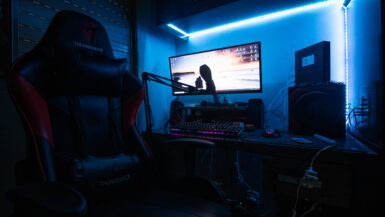In today’s rapidly evolving technological landscape, voice assistants have emerged as a pivotal element in the realm of smart home design and architecture. As an increasing number of homeowners seek seamless integration of intelligent systems within their living spaces, designers and architects are striving to accommodate the growing influence of these voice-enabled devices. In this comprehensive article, we delve into the profound impact of voice assistants on the aesthetics, functionality, and user experience of modern smart homes, while also exploring the challenges and opportunities presented by this innovative technology. Join us as we examine the intricate relationship between voice assistants and smart home design, shedding light on the future of connected living spaces.
Integrating Voice Assistants into Modern Home Design: A Seamless Experience
Voice-enabled smart home devices are altering the way we interact with our homes. By integrating these devices into the very fabric of modern home design, architects and designers are creating living spaces that are not only intelligent but also intuitive and user-friendly. In this section, we explore the various ways in which voice assistants are being woven into the architecture of smart homes, resulting in a truly seamless experience for homeowners.
Designing Spaces with Acoustic Optimization in Mind
One of the primary concerns when integrating voice assistants into a home’s design is ensuring optimal acoustic performance. Architects and designers are increasingly considering the placement of voice-enabled devices in relation to the layout and materials of a room, aiming to reduce echo and background noise. This not only enhances voice recognition capabilities but also contributes to the overall auditory experience within the space.
Intelligent Home Infrastructure
A smart home’s infrastructure plays a crucial role in the seamless integration of voice assistants. By incorporating a robust wiring and network system, designers can ensure that voice-enabled devices are able to communicate effectively with other smart home elements, such as lighting, security, and climate control systems. Additionally, designing a home that facilitates easy upgrades to future voice assistant technologies helps maintain the longevity and adaptability of the smart home environment.
Blending Aesthetics and Functionality
Achieving a perfect balance between aesthetics and functionality is a critical aspect of modern home design. Voice assistants, as essential elements of smart homes, must be integrated in a way that is both visually appealing and easily accessible. Designers are utilizing hidden compartments, custom-built furniture, and other creative solutions to ensure that voice-enabled devices are both unobtrusive and readily available when needed.
Enhancing Accessibility and Inclusivity
The growing prevalence of voice assistants in smart homes is not only about creating a more streamlined user experience but also about enhancing accessibility and inclusivity. By incorporating voice-enabled devices into home design, architects and designers can create spaces that cater to individuals with varying levels of physical ability or technological familiarity. This ultimately results in a living environment that is welcoming, versatile, and adaptable to the needs of all its inhabitants.
Embracing the Future of Connected Living
As voice assistants continue to revolutionize the way we interact with our homes, architects and designers are presented with a unique opportunity to redefine the very essence of modern living spaces. By thoughtfully integrating voice-enabled devices into smart home design, they can create environments that are not only intelligent and efficient but also deeply connected to the lives of their inhabitants. This bold vision of the future offers us a glimpse into the endless possibilities that lie ahead for voice assistant-driven smart homes.
Architectural Innovations for Enhanced Voice Assistant Performance in Smart Homes
As the adoption of voice assistants in smart homes grows, architects and designers are constantly seeking innovative ways to enhance the performance of these devices within the built environment. In this section, we explore several architectural innovations that are paving the way for optimized voice assistant functionality in smart homes, ensuring that homeowners can fully harness the potential of this cutting-edge technology.
Optimizing Room Acoustics for Voice Control
To ensure the best performance of voice assistants, architects are paying close attention to the acoustics of the living spaces they design. By strategically placing sound-absorbing materials and incorporating architectural features that minimize reverberation, designers are creating spaces that facilitate clearer voice commands and more accurate voice recognition.
Integrating Smart Home Hubs for Centralized Control
One of the challenges faced by homeowners using multiple voice-enabled devices is maintaining seamless communication between them. To address this issue, architects are designing smart home hubs – centralized control points that enable efficient communication between all connected devices. These hubs not only streamline the process of controlling various smart home systems but also reduce latency and improve overall voice assistant performance.
Implementing Zoned Audio Systems
Designing smart homes with zoned audio systems allows homeowners to control audio playback in specific areas of the house independently. This architectural innovation contributes to improved voice assistant functionality by reducing audio interference between different spaces, ensuring that voice commands are received clearly and accurately.
Maximizing Natural Light and Ventilation for Enhanced Voice Recognition
Natural light and ventilation play a crucial role in creating comfortable and healthy living spaces. Interestingly, they can also contribute to the performance of voice assistants. By designing homes with large windows and proper ventilation, architects can minimize the impact of environmental factors such as noise, humidity, and temperature fluctuations on voice assistant devices, thereby enhancing their overall performance.
Exploring Adaptive and Modular Design Solutions
As the technology behind voice assistants continues to evolve, architects must ensure that smart homes are adaptable to future advancements. By employing modular design solutions and adaptive architectural elements, designers can create spaces that can easily accommodate new voice assistant technologies, guaranteeing that smart homes remain relevant and functional in the years to come.
This exploration of architectural innovations for enhanced voice assistant performance in smart homes highlights the importance of a holistic approach to smart home design. By considering various factors such as acoustics, connectivity, adaptability, and environmental influences, architects and designers can create living spaces that fully capitalize on the capabilities of voice assistants, delivering an unparalleled user experience for homeowners.
Acoustic Considerations for Optimal Voice Assistant Functionality in Home Spaces
As voice assistants continue to gain popularity in smart homes, architects and designers must pay particular attention to the acoustics of living spaces in order to ensure optimal functionality of these devices. In this subsection, we delve into various acoustic considerations that play a crucial role in enhancing the performance of voice assistants, providing homeowners with a seamless and enjoyable user experience.
Understanding the Importance of Sound Absorption and Reverberation
For voice assistants to accurately understand and respond to user commands, it is essential to minimize the impact of sound reflections and reverberations within a room. By incorporating sound-absorbing materials such as acoustic panels, carpets, and curtains in strategic locations, architects can effectively reduce echo and create a more conducive environment for voice assistant devices.
Strategic Placement of Voice Assistant Devices
The location of voice assistant devices within a room can significantly influence their performance. Architects and designers must consider factors such as distance from walls, proximity to other sound sources, and potential obstructions when determining the optimal placement of these devices. This ensures clear and accurate voice recognition, even in large or complex spaces.
Designing Spaces with Optimal Room Geometry
The shape and size of a room can greatly impact the acoustics and, consequently, the performance of voice assistants. Architects must consider the principles of room geometry when designing spaces, aiming to create rooms with balanced proportions and minimal parallel surfaces. This helps to avoid the buildup of standing waves and excessive reverberation, resulting in clearer voice commands and more precise voice recognition.
Accounting for Sound Transmission and Isolation
Sound transmission between rooms can interfere with the performance of voice assistants, causing misinterpretations or false activations. To address this issue, architects can incorporate sound isolation techniques such as double walls, resilient channels, and insulation materials. These design elements help to minimize sound transmission between spaces and ensure optimal functionality of voice assistant devices.
Consideration of Background Noise Levels
Background noise levels within a home can negatively impact the performance of voice assistants. Architects and designers must take into account potential noise sources such as HVAC systems, appliances, and external sounds when designing smart homes. By utilizing noise-reducing techniques and materials, they can create living spaces that offer a quieter environment for voice assistants to operate effectively.
Taking into account these acoustic considerations can significantly enhance the performance of voice assistant devices in smart homes. By focusing on sound absorption, reverberation, room geometry, sound transmission, and background noise levels, architects and designers can create living spaces that prioritize the functionality of voice assistants, resulting in a more enjoyable and seamless user experience for homeowners.
Voice-Enabled Smart Home Devices: Revolutionizing Home Automation and Accessibility
The integration of voice assistants into smart home design and architecture is transforming the way we interact with our living spaces, creating a more personalized and efficient experience for homeowners. In this subsection, we explore how voice-enabled smart home devices are revolutionizing home automation and accessibility, emphasizing the profound impact these advancements have on our daily lives.
Empowering Users with Hands-Free Control
One of the most significant benefits of voice assistants in smart homes is the ability to manage various home automation systems using simple voice commands. This hands-free control enables users to adjust lighting, temperature, security, and entertainment systems without the need for physical interaction. As a result, homeowners can enjoy a more convenient and streamlined living environment that adapts to their unique preferences and needs.
Personalization and Customization at Your Command
Voice assistants are equipped with advanced learning algorithms that allow them to adapt to individual users’ preferences and habits. As these devices become more attuned to the specific needs of each homeowner, they can deliver a truly personalized experience that enhances both comfort and efficiency. From tailored lighting scenes to customized temperature settings, voice-enabled smart home devices create a living space that is uniquely tailored to their inhabitants.
Breaking Down Barriers for Individuals with Disabilities
Voice assistants are playing a crucial role in making smart homes more accessible and inclusive for individuals with disabilities. By providing a hands-free means of controlling various home automation systems, voice-enabled devices empower those with physical limitations to enjoy greater independence and comfort within their living spaces. This enhanced accessibility is a testament to the transformative potential of voice assistant technology in creating more inclusive smart home environments.
Streamlining Routine Tasks and Enhancing Productivity
The integration of voice assistants into smart home design and architecture has the potential to significantly improve productivity and efficiency within the home. By automating routine tasks such as setting alarms, managing calendars, and controlling appliances, voice-enabled devices allow homeowners to focus on more important activities and enjoy a more balanced lifestyle. This increased productivity is yet another example of the far-reaching influence of voice assistants on our daily lives.
Enriching Daily Life with Intelligent Assistance
Beyond their practical applications, voice assistants also have the ability to enrich our daily lives by providing valuable information, entertainment, and companionship. Whether it’s answering questions, reading the news, or engaging in conversation, these intelligent devices add a new dimension to the smart home experience. As voice assistants continue to evolve and improve, their potential to positively impact our lives will only grow.
The integration of voice-enabled smart home devices in modern home design and architecture is undeniably reshaping our living spaces and lifestyles. By revolutionizing home automation, personalization, accessibility, and productivity, these innovative assistants have the power to transform our homes into more intelligent, efficient, and enjoyable environments. As we embrace the future of connected living, the influence of voice assistants on smart home design and architecture will undoubtedly continue to expand and evolve.
Privacy and Security Concerns: Balancing Functionality and Safety in Voice Assistant-Integrated Homes
As voice assistants continue to shape the landscape of smart home design and architecture, it is essential to address the potential privacy and security concerns associated with these devices. While they undoubtedly offer numerous benefits in terms of convenience and accessibility, homeowners must also be aware of the risks and take necessary precautions to ensure that their living spaces maintain a balance between functionality and safety. In this subsection, we explore various privacy and security concerns related to voice assistant-integrated homes and offer suggestions for mitigating these risks while still benefiting from the advantages of this innovative technology.
Protecting Sensitive Data and Personal Information
One of the primary concerns associated with voice assistants is the potential for unauthorized access to sensitive data and personal information. To minimize this risk, homeowners can implement various security measures such as strong passwords, two-factor authentication, and regular software updates. Additionally, it is crucial to educate all household members on the importance of privacy and security when interacting with voice-assistant devices.
Addressing Eavesdropping and Unintended Activation
Voice assistants may inadvertently record conversations or activate when they misinterpret background noise or conversations as voice commands. To address this concern, homeowners can make use of privacy features such as mute buttons and customizable wake words, as well as regularly reviewing and deleting voice recordings within the device’s settings.
Securing Home Networks and Connected Devices
Given the interconnected nature of smart homes, it is essential to ensure that all connected devices, including voice assistants, are protected from potential cyber threats. Homeowners can secure their home networks by investing in robust firewalls and antivirus software, as well as regularly updating all device firmware to patch potential vulnerabilities.
Maintaining Privacy in Shared Living Spaces
In shared living spaces, privacy concerns may arise when multiple individuals have access to the same voice assistant. To address this issue, homeowners can configure voice assistants to recognize individual voices and create separate user profiles, thereby ensuring that personal information and preferences remain private.
Staying Informed and Proactively Addressing Concerns
As voice assistant technology continues to evolve, it is important for homeowners to stay informed about potential risks and new security features. By proactively assessing and addressing privacy and security concerns, homeowners can enjoy the many benefits of voice assistant-integrated homes without compromising their safety.
In conclusion, integrating voice assistants into smart home design and architecture presents a unique set of privacy and security challenges. However, by taking the necessary precautions and remaining vigilant, homeowners can strike a balance between enjoying the convenience and functionality of these devices while maintaining a safe and secure living environment. The future of smart homes will undoubtedly continue to be shaped by voice assistant technology, making it essential for homeowners, designers, and architects to prioritize both functionality and safety in their approach to connected living spaces.





Leave a reply